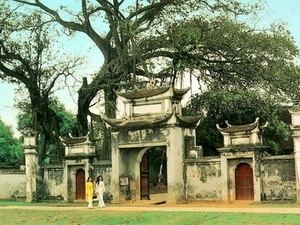 | ||
Cổ Loa Citadel (Vietnamese: Thành Cổ Loa) is a citadel in present-day Hanoi's Dong Anh district, about 16 kilometers (10 mi) northeast of downtown. It was erected during the end of the Hồng Bàng Dynasty (about 257 BCE). The fortress is a spiral-shaped complex of the then new capital. Its name is derived from the Sino-Vietnamese 古螺, meaning "old spiral." The site has been the source of various relics of the Dong Son culture of the Bronze Age.
Contents
Map of C%E1%BB%95 Loa, %C4%90%C3%B4ng Anh, Hanoi, Vietnam
History
According to folklore, Thục Phán (An Dương Vương) defeated the last of the Hung kings in 257 BCE and founded the kingdom of Âu Lạc, choosing the site of Co Loa as his capital. Co Loa is a very large site and is the dominant presence in the northern floodplain of the Red River Delta, which would have required a large amount of labour and resources to have built in its time.
The story goes that when the city was first being built, the work done during the day was destroyed at night. The king made a sacrifice and that night a golden turtle came to him in a dream and told him that the king was building the city on the turtle's carapace. Instead, the king was instructed to build the city in a new location - that of present-day Co Loa. The king did so, and the city was soon finished.
The city was in the shape of a conch shell and had 9 walls, each of which was protected by a moat. The moats were part of a series of streams—including the Hoang Giang River to the south—and lakes that exist to this day and provided Co Loa with protection and navigation.
Out of gratefulness to the king, the magic turtle gave the king a claw that he could use as a trigger on his crossbow. When used, it multiplied its force by the thousands. However, one of the Qin dynasty leaders, Zhao Tuo, took advantage of the decline of the Qin and created his own kingdom north of Au Lac. He tried to conquer his southern neighbor but was defeated. Instead, he married his son to the daughter of the Thuc king. When the son was in Co Loa, he discovered the magic turtle's claw and stole it. His father invaded the Au Lac and Co Loa and easily defeated it.
Stories of the Thuc king's demise vary. Some say he committed suicide by jumping in the ocean. Some say he was born off to sea by the magic turtle and never seen again. Some say he was told of his daughter's betrayal by the magic turtle and killed his own daughter before he disappeared with the turtle.
Archaeology
The site consists of two outer sets of ramparts and a citadel on the inside, of rectangular shape.
The outer rampart comprises a perimeter of 8 km and is lined with guard towers. The ramparts still stand up to 12 m high and are 25 m in width at their base. Besides, part of the inner rampart was cut through for the purpose of archaeological investigation, which was dated from 400-350 BC.And it was suggested that this rampart was constructed by a local and indigenous society prior to the colonization of Han dynasty. Also, archaeologists have estimated that over two million cubic metres of material were moved in order to construct the entire fortress, including moats that were fed by the Hoang River.
Then in 2007 - 2008 another excavation took place that excavated the middle wall of Co Loa citadel. The excavation cut through the entire width of the rampart. The stratification showed multiple layers of construction deposits: three periods and five major phases of construction.
Excavations made by archaeologists have revealed Dong Son style pottery that had stratified over time under the walls, while a drum was found by chance by Nguyen Giang Hai and Nguyen Van Hung. The drum included a hoard of bronze objects. The rarity of such objects in Southeast Asia and the range found at Co Loa is believed to possibly be unique.
The drum itself is one of the largest Bronze Age drums to have been recovered from the Red River Delta, standing 57 cm high and boasting a tympanum with a diameter of 73.6 cm. The drum itself weighs 72 kg and contains around 200 pieces of bronze, including 20 kg of scrap pieces from a range of artefacts. These include socketed hoes and ploughshares, socketed axes, and spearheads.
The artifacts are numerically dominated by the ploughshares, of which there are 96. Six hoes and a chisel were in the set. There were 32 socketed axes of various shapes, including a boat shaped axehead. This was almost a replica to a clay mound found in the grave of the bronze metalworker at Lang Ca.
Sixteen spearheads, a dagger and eight arrowheads were also found. One spearhead generated special interest because it was bimetallic, with an iron blade fitting into a bronze socket.
